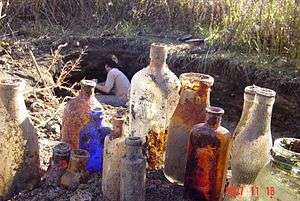Dump digging

Dump digging is the practice of locating and excavating old garbage dumps with the intent of discovering objects which have potential value as collectibles or antiques.[1] These dumps are sometimes centuries old but often date to the late 19th century or early part of the 20th century. Among other things, the practice of dump digging is directly linked to antique bottle collecting and glassmaking.[2]
It is a form of historical digging which involves long hours working with a shovel, pick and other hand tools. Finding evidence of potential antique bottle dumps or middens is done by searching areas where it is likely that older garbage was deposited. Diggers generally look for clues of pre1920s junk piles in the woods or down embankments, places where old houses or businesses stand or once stood. Hiking along waterways and swampy areas, particularly during droughts, can also produce important clues and lead to good discoveries.
Additionally, many coastal cities are surrounded by landfills or “tips”, places where enormous quantities of trash were deposited in the past intended to create additional acres of viable real estate. It can take many months of searching each of these locations for a decent dig to be surface.
Background and controversies
Dump digging for potentially valuable collectibles is at least as old as the Pharaohs. For practical reasons dump diggers often use a much less forensic style than academic archeologists or museum curators would on their projects. Not unlike the privies, cisterns and wells that other historical diggers explore and salvage in, dumps are typically fleeting sources. They are often located on properties which are in the process of being permanently altered by major development and other factors.
Items found and locations

Dump digging can yield different items and artifacts in each location. A town dump can be somewhat different than a farm dump or a railroad dump but in each case there could be industrial age pottery, stoneware, china, tobacco pipes, military relics like bayonets and gun barrels, musket balls, uniform buttons and other buttons, marbles and an assortment of other things. A high percentage of these dump discoveries are routinely found in severe states of decay, damaged or broken altogether. In many cases even the things which have stood the test of time remarkably well have little if any monetary value. There are many exceptions to this general rule that keep dump diggers busy searching and occasionally they are surprised by what they unearth working their sites.
Through the common process known as tipping, vast amounts of refuse generated by towns and cities were dumped into harbors, along marshy shorelines and other areas while forming viable real estate cheaply.[3] Excavating in these areas is also a form of dump digging. Elusive and often deep, small portions of these ashy landfill dumps are sometimes rediscovered during major development projects. Enormous quantities of a given locations everyday trash were deposited into these often difficult to reach locales.
The bulk of this garbage has never been investigated and at present much of it is still undiscovered. Through researching and active searching occasionally the opportunity arises to dig into small portions and find old bottles and other objects which survive remarkably well as curiosities, collectibles or antiques. For centuries active waterways were also frequently converted into major dumping spots for household and industrial refuse but they are generally impossible to reach without expensive equipment. Along with the existing information generated from the efforts of dump diggers and others, a wealth of additional information is waiting among these widely distributed landfills and other dumping spots.
See also
- Garbology
- Historical digging
- Privy digging
- Landfill mining
- Metal detector
- Midden
- Tucson Garbage Project
References
- ↑ "Dumps are a window into history". Toronto Star. January 23, 2009.
Campbell and the others call themselves "dumpdiggers," shoveling for signs of the past – pottery, bottles, buttons, cutlery, moustache cups – wherever people once tossed garbage.
- ↑ "Historic Glass Bottle Identification & Information Website". Glassmaking & Glassmakers. Retrieved 2011-07-15.
- ↑ Miller, B. (2000). Fat of the Land: Garbage in New York: The Last Two Hundred Years. New York: Four Walls Eight Windows. ISBN 1-56858-172-6.
Further reading
- Woodhams, John (1998) Have You Got the Bottle? a basic guide to bottle collecting & digging. London: London League Publications; ISBN 0-9526064-8-8